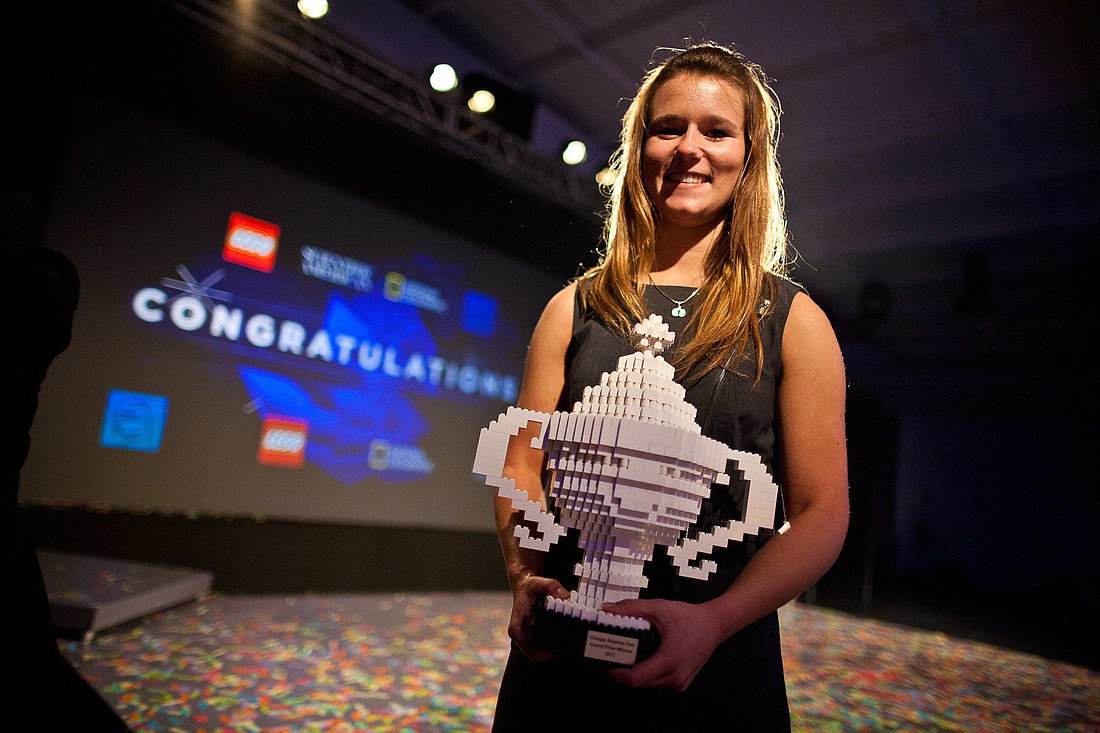- April 18, 2024
-
-
Loading

Loading

Lakewood Ranch resident and Out-of-Door Academy student Brittany Wenger not only competed as a top 15 finalist in the Google Science Fair last week, but she also won her age division and the grand prize July 23.
“I’m really excited that I won,” Wenger said after the competition. “It was very surreal. I don’t think anybody’s prepared to handle anything like that. The next few hours were a blur. I was not expecting it.
“I’m sure it was tough for the judges to decide, but (my project is) different,” she said. “It has huge implications. When doctors start using it, breast-cancer detection will be less invasive, and early detection will be a possibility.
Wenger now plans to take her project, called Global Neural Network Cloud Service for Breast Cancer, to hospitals nationwide for beta testing. She also wants to extend its application to other types of cancers and medical diagnostics.
Below is a first-hand account Wenger wrote about her experience:
IN HER OWN WORDS
The most surreal moment of my life would be the experience of having confetti rain down to celebrate winning the Google Science Fair. Excitement was everywhere! Finalists all were proud to be affiliated with the event, and every project in the finals deserved confetti. For the judges to acknowledge my research as worthy of top prize is awe-inspiring.
Winning a $50,000 scholarship, a 10-day National Geographic Excursion to the Galapagos Islands and a Google Zurich research experience is life changing.
There were many incredible moments in the jam-packed, four-day whirlwind through Google Headquarters in Mountain View, Calif., as one of this year’s 15 Google Science Fair finalists. During one of my judging discussions, I spoke at length with Vint Cerf, recognized as one of the fathers of the Internet, about cloud computing and how I was applying it to help in the battle against breast cancer. I also interacted with Ada Yonath, a Nobel Prize winner in chemistry for her contributions to discovering the ribosome structure.
I established relationships with all 15 judges during the adventure — judges who are the who’s who of science, including Steve Myers, director of accelerators and technology at CERN, where the Higgs Boson discoveries continue, National Geographic Explorers, a top LEGO designer and others from the science community. Every person I interacted with, whether judges, fellow finalists, Google employees or the public, was genuinely interested and excited about my research.
My project is Global Neural Network Cloud Service for Breast Cancer. It is an artificial neural network, a program coded to learn based on mistakes and experiences, so it can detect patterns far too complex for humans to detect. I applied the program to breast-cancer diagnostics, because, currently, fine needle aspirates, the least invasive biopsies, are also the least conclusive. I then deployed my network to the cloud so that it is accessible to doctors worldwide as a convenient tool that can lead to breast-cancer diagnostics becoming quicker, less invasive and cheaper. The network is 99.11% sensitive to malignancy. Through 7.6 million trials, I have proven with more data, the network’s success increases and should achieve hospital-ready success.
The Google Science Fair is the largest online science fair in the world and attracted thousands of entries from more than 100 countries. Finalists hailed from Canada, India, Malta, Spain, Swaziland, Ukraine and the U.S.
Google paid to fly each of us to the event with a chaperone. I call it an event, because this was so much more than just a science fair; it was an incredible experience. Once there, we had the opportunity to interact in the “crash pad” and form lifelong friendships. The crash pad was stocked with ping-pong, battle bots, video games, bean bags and a claw machine. Not only did we bond in the crash pad, but during our time away from judging, we also got to ride in self-driving cars, explore the Google campus and tour San Francisco. I’m pretty sure we were able to experience more of the city in a day than a typical tourist sees in a week.
It was so nice to be able to meet other kids who share my passion for science. I know I will treasure these moments in years to come.
— Brittany Wenger
TIMELINE
DAY 1 (July 21): Arrived; video crew waiting, met everybody in the “crash pad”; icebreakers.
DAY 2 (July 22): Went to Google headquarters; participated in activities such as riding in a self-driving car; project set-up; judging discussions, judges and finalist attend carnival; crash pad.
DAY 3 (Monday, July 23) Science fair open to the public; formal judging presentations given (each finalist was given a time slot to present a Google presentation to all 15 judges; it was exciting to have 15 of the most prominent scientists sitting at a round table to listen to my work!); tour of Google; LEGO robot activity; awards gala; crash pad celebration.
DAY 4 (Tuesday, July 24): Tour of San Francisco (sights visited include the Golden Gate Bridge, City Hall, California Academy of Sciences, Almo Square Park, Trolley and Macy’s Burger Bar).